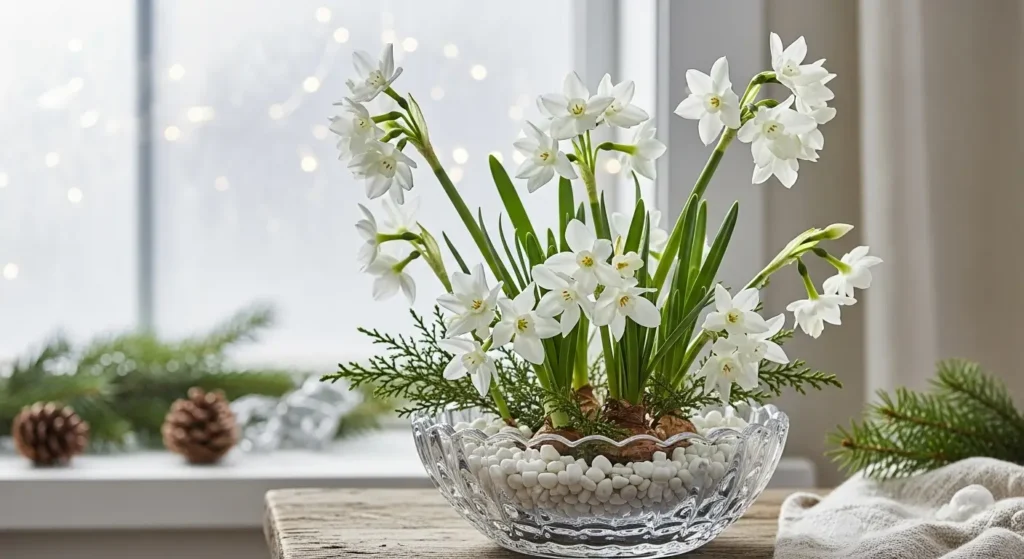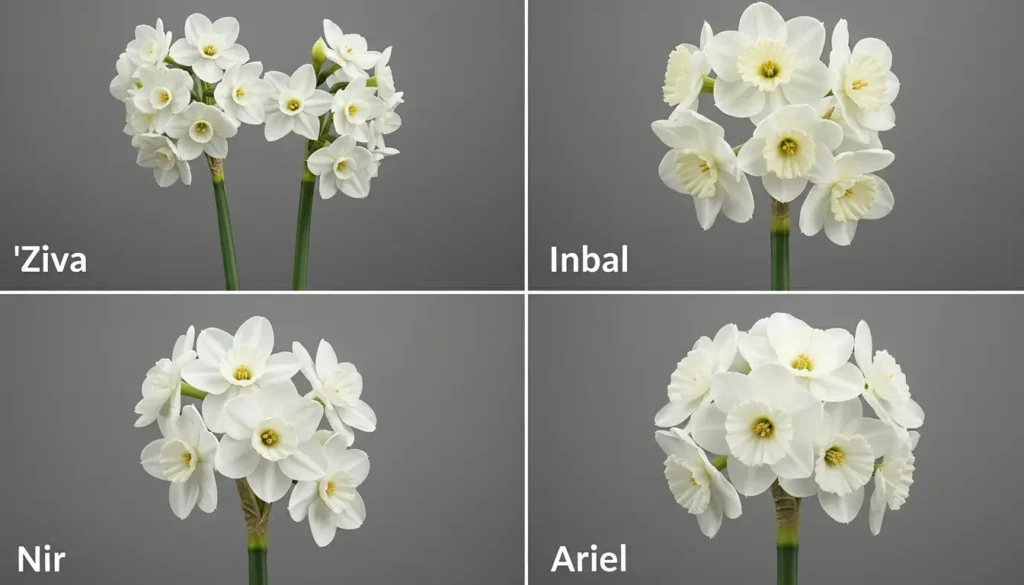
In This Article
If you’re celebrating a December birthday, you’re lucky to have one of winter’s most enchanting blooms as your birth flower. The December birth flower, paperwhite narcissus, brings delicate white blooms and sweet fragrance to the coldest months. Native to the Mediterranean region, these charming bulbs have been cherished since ancient times.
They’re one of the easiest flowering bulbs to grow indoors, making them perfect for beginners. With their clusters of star-shaped white flowers, the December birth flower symbolizes hope, renewal, and new beginnings fitting sentiments for the final month of the year.
Paperwhite Narcissus Info Card
| Attribute | Details |
|---|---|
| Common Name | Paperwhite Narcissus, Paperwhite |
| Botanical Name | Narcissus papyraceus |
| Family | Amaryllidaceae |
| Plant Type | Bulbous perennial |
| Mature Size | 12-18 inches tall, 6-8 inches wide |
| Sun Exposure | Bright indirect light |
| Soil Type | Well-draining potting mix or pebbles |
| Soil pH | 6.0-7.0 |
| Hardiness Zones | 8-11 (usually grown indoors) |
| Native Area | Mediterranean region |
| Toxicity | Toxic to pets and humans |
December Birth Flower Care
The December birth flower is surprisingly easy to grow, especially indoors during winter months. In the following sections, we’ll cover everything from light requirements to propagation methods.
Light
The December birth flower thrives in bright indirect light, making it ideal for sunny windowsills during winter. Place your paperwhites near an east or south-facing window where they receive plenty of natural light without harsh afternoon sun. Too little light causes leggy, weak stems that flop over easily.
According to The Old Farmer’s Almanac, proper lighting is essential for sturdy growth. For best results, rotate your container every few days to encourage even growth. If your only option is a spot with less light, consider using a grow light to supplement natural sunlight.
Soil
The ideal soil for the December birth flower is well-draining potting mix with good aeration to prevent bulb rot. You can also grow them in decorative bowls filled with pebbles, stones, or marbles no soil required. If using potting mix, choose a lightweight blend that drains quickly yet retains some moisture. According to Iowa State University Extension, well-draining conditions are crucial because bulbs sitting in waterlogged soil quickly develop rot. The soil pH should range from slightly acidic to neutral for optimal growth.
Water
Water your December birth flower carefully to keep the growing medium consistently moist but never soggy. When forcing in pebbles, maintain water levels just below the bulb’s base about a quarter inch gap prevents rot while allowing roots to reach moisture. Check water levels daily, as actively growing bulbs can dry out quickly. If you’re using potting soil, water when the top inch feels dry to the touch. Just like with spider plant care, consistent moisture is key. During the blooming period, water slightly less frequently but don’t let the medium dry out completely.
Temperature and Humidity
The December birth flower prefers cool to moderate temperatures between 50-65°F for compact, sturdy growth. Warmer rooms above 68°F cause leggy stems and shortened bloom time, so avoid placing your narcissus near heat vents or radiators. Average household humidity around 40-50% works perfectly fine no special humidifiers needed. Once buds appear, you can move the container to a slightly warmer spot for enjoyment, but cooler temperatures extend bloom longevity.
Fertilizer
Feed your December birth flower every two weeks with a half-strength balanced liquid fertilizer from planting until buds appear. Stop fertilizing once blooms open to extend their display. During the blooming phase, feeding isn’t necessary and may actually shorten flower life. Similar to peace lily care, proper fertilization timing matters for optimal blooms.
Types of December Birth Flower

While the classic December birth flower is most common, several varieties offer subtle differences perfect for winter forcing:
- ‘Ziva’ – The most popular variety, ‘Ziva’ produces pure white flowers with a strong fragrance and grows 12-18 inches tall. This Israeli-bred cultivar blooms reliably within 4-6 weeks.
- ‘Inbal’ – A large-flowered cultivar with creamy white blooms and mild, pleasant fragrance that’s less overpowering than ‘Ziva’. It reaches 12-16 inches tall with stronger stems.
- ‘Nir’ – Distinguished by its pale yellow center contrasting with white petals, ‘Nir’ grows 14-18 inches and offers a lighter scent than traditional paperwhites.
- ‘Ariel’ – This variety features extra-large white flowers on thick, sturdy stems that rarely need staking. The classic fragrance remains strong, and it grows 12-16 inches tall.
Propagating December Birth Flower
The best time to propagate the December birth flower is during late spring and summer after foliage dies back. Let’s explore the most effective method for multiplying your collection.
Propagating by Bulb Division
Bulb division is the primary propagation method for the December birth flower and ensures identical plants to the parent. You’ll need a garden fork, sharp knife, fresh potting mix, and small pots.
Step 1: Wait until foliage has completely yellowed and died back naturally in late spring or early summer, which allows the bulb to store maximum energy.
Step 2: Carefully dig around the bulb clump with a garden fork, lifting the entire mass without damaging bulbs or their offsets (small bulbs forming around the base).
Step 3: Gently separate offset bulbs from the mother bulb by hand, or use a clean knife if they’re firmly attached, making sure each division has roots.
Step 4: Replant larger offsets immediately in fresh, well-draining soil, or store them in a cool, dry place until fall planting time. Similar to kalanchoe plants, expect flowers from larger offsets within 2-3 years.
Potting and Repotting

For indoor forcing, plant December birth flower bulbs in fall through early winter for December blooms. Choose containers 4-6 inches deep shallow bowls work beautifully for displaying multiple bulbs together. When forcing the December birth flower, you don’t need drainage holes if using pebbles and water. However, if using potting soil, drainage becomes essential.
Fill your container one-third to halfway with pebbles or potting mix, position bulbs close together (almost touching) with pointed ends up, and nestle them into the medium. Add more pebbles or soil around bulbs, leaving the top third exposed. For pebble forcing, add water until it just touches bulb bottoms. The Royal Horticultural Society recommends this method for successful indoor forcing. With soil, water thoroughly and let drain completely. Paperwhites forced indoors are typically discarded after blooming since they rarely bloom again.
Common Pests and Diseases
Like most indoor bulbs, the December birth flower can occasionally attract pests during the growing season. Early detection keeps your paperwhites healthy throughout winter.
Spider Mites
Look for tiny webbing between leaves and stems, plus stippled yellow spots on foliage. Treat immediately with insecticidal soap spray or neem oil, coating all plant surfaces every 3-5 days.
Aphids
Soft-bodied green or black insects congregate on new growth and buds where they feed on sap. Spray aphids off with a strong water stream or apply insecticidal soap following label directions.
Fungus Gnats
Small black flies hovering around soil indicate fungus gnat larvae feeding on roots. Allow soil to dry slightly between waterings and apply Bacillus thuringiensis (Bt) to eliminate larvae.
Common Problems with December Birth Flower
Here’s how to troubleshoot common issues when growing your December birth flower:
Yellow Leaves
Yellowing foliage on the December birth flower typically signals overwatering or natural aging after blooming finishes. If bulbs feel soft, reduce watering immediately. However, yellowing leaves after flowers fade is completely normal the bulb is entering dormancy. Just like with neon pothos, yellowing isn’t always a problem requiring intervention.
Leggy Growth or Flopping Stems
Insufficient light is the primary culprit when the December birth flower develops tall, weak stems that bend or topple over easily. Move your paperwhites to a brighter location immediately, ideally near a sunny window. Additionally, temperatures above 70°F encourage excessively tall, spindly growth. Keep plants in cooler rooms (50-65°F) for compact, sturdy stems.
Flower Buds That Won’t Open
Bud blast occurs when December birth flower buds shrivel and brown without opening, usually caused by insufficient water or overly warm, dry conditions. Keep growing medium consistently moist and maintain cooler temperatures between 50-65°F for best bud development. Similar problems affect heart-leaf philodendron when conditions become too dry.
No Blooms Appearing
If your December birth flower bulbs produce foliage but no flowers, several factors might be responsible including undersized bulbs (choose bulbs 16+ cm diameter), insufficient light exposure, or previously forced bulbs that lack energy. Fresh, high-quality bulbs bloom most reliably indoors paperwhites can’t typically be forced a second time successfully.
FAQ
What is December’s birth flower?
December’s primary birth flower is paperwhite narcissus, known for fragrant white blooms that brighten winter months. Holly also represents December with its festive red berries and evergreen leaves.
Why does December have two flowers?
December has two birth flowers—narcissus and holly—because this tradition allows representation of different aspects: one tender bloom (narcissus) and one hardy evergreen (holly) reflecting December’s complexity.
What is a December birth flower tattoo?
A December birth flower tattoo typically features paperwhite narcissus blooms or holly leaves and berries, symbolizing hope, renewal, protection, and new beginnings for those born in December.
What flower is associated with the month of December?
The December birth flower, paperwhite narcissus, is the primary flower associated with December, chosen because it blooms naturally in winter, unlike spring-flowering daffodils. Holly serves as December’s secondary symbolic plant.
